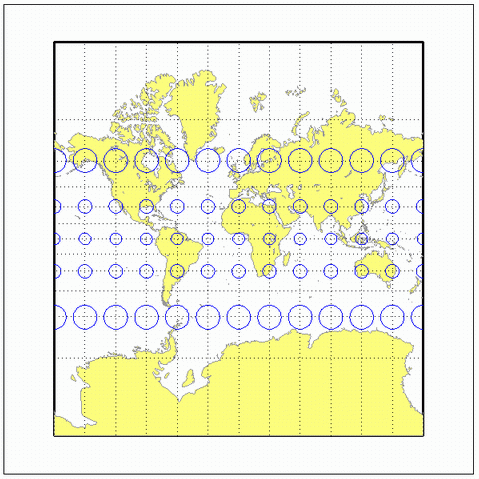mercator
Mercator Projection
Classification
Cylindrical
Identifier
mercator
Graticule
Meridians: Equally spaced straight parallel lines.
Parallels: Unequally spaced straight parallel lines, perpendicular to the meridians. Spacing increases toward the poles.
Poles: Cannot be shown.
Symmetry: About any meridian or the Equator.
Features
This is a projection with parallel spacing calculated to maintain conformality. It is not equal-area, equidistant, or perspective. Scale is true along the standard parallels and constant between two parallels equidistant from the Equator. It is also constant in all directions near any given point. Scale becomes infinite at the poles. The appearance of the Mercator projection is unaffected by the selection of standard parallels; they serve only to define the latitude of true scale.
The Mercator, which may be the most famous of all projections, has the special feature that all rhumb lines, or loxodromes (lines that make equal angles with all meridians, i.e., lines of constant heading), are straight lines. This makes it an excellent projection for navigational purposes. However, the extreme area distortion makes it unsuitable for general maps of large areas.
Parallels
For cylindrical projections, only one standard parallel is specified. The other standard parallel is the same latitude with the opposite sign. For this projection, any latitude less than 86º may be chosen; the default is arbitrarily set to 0º.
Remarks
The Mercator projection is named for Gerardus Mercator, who presented it for navigation in 1569. It is now known to have been used for the Tunhuang star chart as early as 940 by Ch'ien Lo-Chih. It was first used in Europe by Erhard Etzlaub in 1511. It is also, but rarely, called the Wright projection, after Edward Wright, who developed the mathematics behind the projection in 1599.
Mapping Toolbox™ uses a different implementation of the Mercator projection for displaying coordinates on
axesm-based maps than for projecting coordinates using theprojfwdorprojinvfunction. These implementations may produce differing results.
Limitations
Data at latitudes greater than 86º is trimmed to prevent large y-values from dominating the display.
Example
landareas = shaperead('landareas.shp','UseGeoCoords',true);
axesm ('mercator', 'Frame', 'on', 'Grid', 'on');
geoshow(landareas,'FaceColor',[1 1 .5],'EdgeColor',[.6 .6 .6]);
tissot;
Version History
Introduced before R2006a